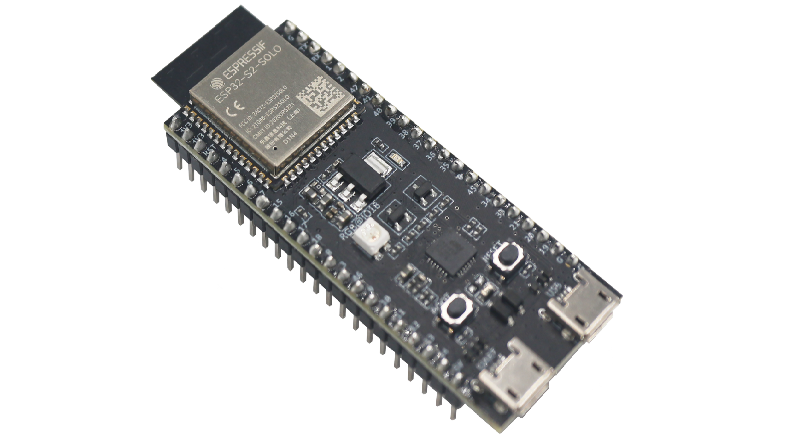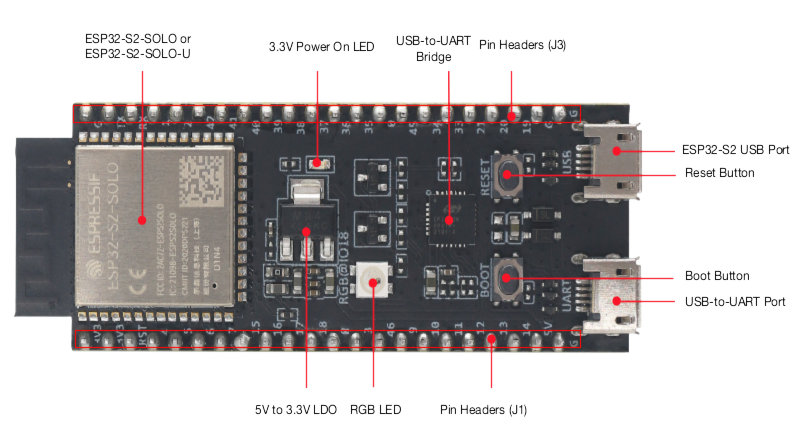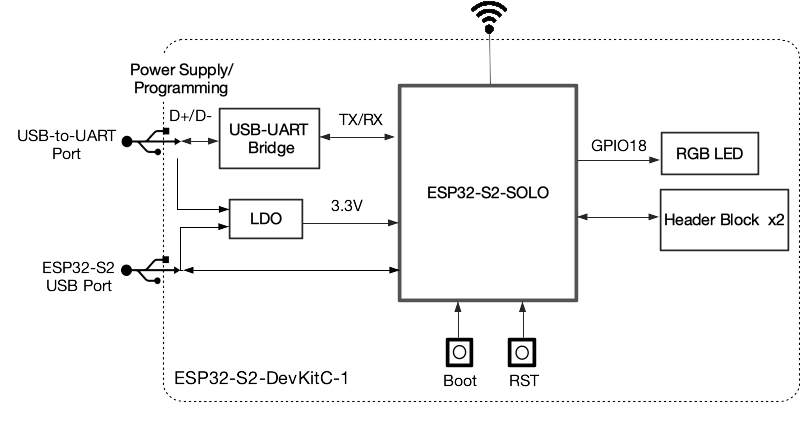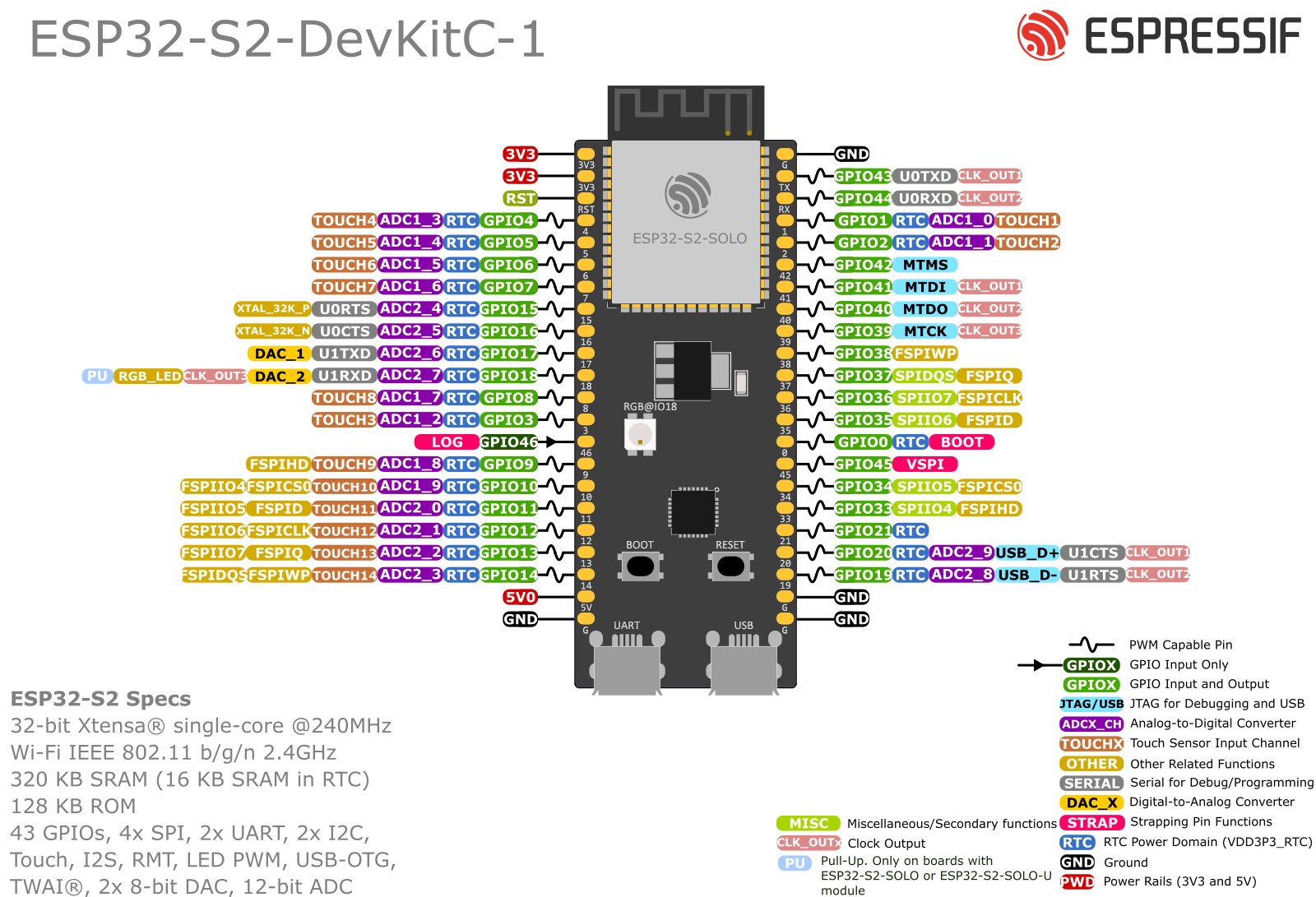ESP32-S2-DevKitC-1
This user guide will help you get started with ESP32-S2-DevKitC-1 and will also provide more in-depth information.
ESP32-S2-DevKitC-1 is an entry-level development board. This board integrates complete Wi-Fi functions. Most of the I/O pins are broken out to the pin headers on both sides for easy interfacing. Developers can either connect peripherals with jumper wires or mount ESP32-S2-DevKitC-1 on a breadboard.

ESP32-S2-DevKitC-1 with the ESP32-S2-SOLO Module
The document consists of the following major sections:
Getting Started: Overview of ESP32-S2-DevKitC-1 and hardware/software setup instructions to get started.
Hardware Reference: More detailed information about the ESP32-S2-DevKitC-1's hardware.
Hardware Revision Details: Revision history, known issues, and links to user guides for previous versions (if any) of ESP32-S2-DevKitC-1.
Related Documents: Links to related documentation.
Getting Started
This section provides a brief introduction of ESP32-S2-DevKitC-1, instructions on how to do the initial hardware setup and how to flash firmware onto it.
Description of Components

ESP32-S2-DevKitC-1 - front
The key components of the board are described in a clockwise direction.
Key Component |
Description |
|---|---|
On-board module (ESP32-S2-SOLO or ESP32-S2-SOLO-U in the above figure) |
ESP32-S2-SOLO series modules with an on-board PCB antenna or a connector for an external antenna. This series of modules have multiple options for flash and PSRAM size. For more information, please refer to Ordering Information. |
3.3 V Power On LED |
Turns on when the USB power is connected to the board. |
USB-to-UART Bridge |
Single USB-to-UART bridge chip provides transfer rates up to 3 Mbps. |
Pin Headers |
All available GPIO pins (except for the SPI bus for flash) are broken out to the pin headers on the board. For details, please see Header Block. |
ESP32-S2 USB Port |
ESP32-S2 full-speed USB OTG interface, compliant with the USB 1.1 specifications. The interface is used for power supply to the board, for flashing applications to the chip, and for communication with the chip using USB 1.1 protocols. |
Reset Button |
Press this button to restart the system. |
Boot Button |
Download button. Holding down Boot and then pressing Reset initiates Firmware Download mode for downloading firmware through the serial port. |
USB-to-UART Port |
A Micro-USB port used for power supply to the board, for flashing applications to the chip, as well as the communication with the chip via the on-board USB-to-UART bridge. |
RGB LED |
Addressable RGB LED, driven by GPIO18. |
5 V to 3.3 V LDO |
Power regulator that converts a 5 V supply into a 3.3 V output. |
Start Application Development
Before powering up your ESP32-S2-DevKitC-1, please make sure that it is in good condition with no obvious signs of damage.
Required Hardware
ESP32-S2-DevKitC-1
USB 2.0 cable (Standard-A to Micro-B)
Computer running Windows, Linux, or macOS
Note
Be sure to use an appropriate USB cable. Some cables are for charging only and do not provide the needed data lines nor work for programming the boards.
Hardware Setup
Connect the board with the computer using USB-to-UART Port. Connection using ESP32-S2 USB Port is not fully documented. In subsequent steps, USB-to-UART Port will be used by default.
Software Setup
Please proceed to ESP-IDF Get Started, where Section Installation Step by Step will quickly help you set up the development environment and then flash an application example into your ESP32-S2-DevKitC-1.
Contents and Packaging
Ordering Information
The development board has a variety of variants to choose from, as shown in the table below.
Ordering Code |
On-board Module 1 |
Flash |
PSRAM |
Antenna |
|---|---|---|---|---|
ESP32-S2-DevKitC-1-N8R2 |
ESP32-S2-SOLO-2 (Recommended) |
8 MB |
2 MB |
PCB on-board antenna |
ESP32-S2-DevKitC-1U-N8R2 |
ESP32-S2-SOLO-2U (Recommended) |
8 MB |
2 MB |
External antenna connector |
ESP32-S2-DevKitC-1 |
ESP32-S2-SOLO |
4 MB |
--- |
PCB on-board antenna |
ESP32-S2-DevKitC-1U |
ESP32-S2-SOLO-U |
4 MB |
--- |
External antenna connector |
ESP32-S2-DevKitC-1R |
ESP32-S2-SOLO |
4 MB |
2 MB |
PCB on-board antenna |
ESP32-S2-DevKitC-1RU |
ESP32-S2-SOLO-U |
4 MB |
2 MB |
External antenna connector |
- 1
The ESP32-S2-SOLO-2 and ESP32-S2-SOLO-2U modules use chip revision v1.0, and the rest use chip revision v0.0. For more information about chip revisions, please refer to ESP32-S2 Series SoC Errata.
Retail orders
If you order a few samples, each ESP32-S2-DevKitC-1 comes in an individual package in either antistatic bag or any packaging depending on your retailer.
For retail orders, please go to https://www.espressif.com/en/contact-us/get-samples.
Wholesale Orders
If you order in bulk, the boards come in large cardboard boxes.
For wholesale orders, please go to https://www.espressif.com/en/contact-us/sales-questions.
Hardware Reference
Block Diagram
The block diagram below shows the components of ESP32-S2-DevKitC-1 and their interconnections.

ESP32-S2-DevKitC-1 (click to enlarge)
Power Supply Options
There are three mutually exclusive ways to provide power to the board:
USB-to-UART Port and ESP32-S2 USB Port (either one or both), default power supply (recommended)
5V and G (GND) pins
3V3 and G (GND) pins
Header Block
The two tables below provide the Name and Function of the pin headers on both sides of the board (J1 and J3). The pin header names are shown in ESP32-S2-DevKitC-1 - front. The numbering is the same as in the ESP32-S2-DevKitC-1 Schematic (PDF).
J1
No. |
Name |
Type 2 |
Function |
|---|---|---|---|
1 |
3V3 |
P |
3.3 V power supply |
2 |
3V3 |
P |
3.3 V power supply |
3 |
RST |
I |
CHIP_PU |
4 |
4 |
I/O/T |
RTC_GPIO4, GPIO4, TOUCH4, ADC1_CH3 |
5 |
5 |
I/O/T |
RTC_GPIO5, GPIO5, TOUCH5, ADC1_CH4 |
6 |
6 |
I/O/T |
RTC_GPIO6, GPIO6, TOUCH6, ADC1_CH5 |
7 |
7 |
I/O/T |
RTC_GPIO7, GPIO7, TOUCH7, ADC1_CH6 |
8 |
15 |
I/O/T |
RTC_GPIO15, GPIO15, U0RTS, ADC2_CH4, XTAL_32K_P |
9 |
16 |
I/O/T |
RTC_GPIO16, GPIO16, U0CTS, ADC2_CH5, XTAL_32K_N |
10 |
17 |
I/O/T |
RTC_GPIO17, GPIO17, U1TXD, ADC2_CH6, DAC_1 |
11 |
18 3 |
I/O/T |
RTC_GPIO18, GPIO18, U1RXD, ADC2_CH7, DAC_2, CLK_OUT3, RGB LED |
12 |
8 |
I/O/T |
RTC_GPIO8, GPIO8, TOUCH8, ADC1_CH7 |
13 |
3 |
I/O/T |
RTC_GPIO3, GPIO3, TOUCH3, ADC1_CH2 |
14 |
46 |
I |
GPIO46 |
15 |
9 |
I/O/T |
RTC_GPIO9, GPIO9, TOUCH9, ADC1_CH8, FSPIHD |
16 |
10 |
I/O/T |
RTC_GPIO10, GPIO10, TOUCH10, ADC1_CH9, FSPICS0, FSPIIO4 |
17 |
11 |
I/O/T |
RTC_GPIO11, GPIO11, TOUCH11, ADC2_CH0, FSPID, FSPIIO5 |
18 |
12 |
I/O/T |
RTC_GPIO12, GPIO12, TOUCH12, ADC2_CH1, FSPICLK, FSPIIO6 |
19 |
13 |
I/O/T |
RTC_GPIO13, GPIO13, TOUCH13, ADC2_CH2, FSPIQ, FSPIIO7 |
20 |
14 |
I/O/T |
RTC_GPIO14, GPIO14, TOUCH14, ADC2_CH3, FSPIWP, FSPIDQS |
21 |
5V |
P |
5 V power supply |
22 |
G |
G |
Ground |
J3
No. |
Name |
Type |
Function |
|---|---|---|---|
1 |
G |
G |
Ground |
2 |
TX |
I/O/T |
U0TXD, GPIO43, CLK_OUT1 |
3 |
RX |
I/O/T |
U0RXD, GPIO44, CLK_OUT2 |
4 |
1 |
I/O/T |
RTC_GPIO1, GPIO1, TOUCH1, ADC1_CH0 |
5 |
2 |
I/O/T |
RTC_GPIO2, GPIO2, TOUCH2, ADC1_CH1 |
6 |
42 |
I/O/T |
MTMS, GPIO42 |
7 |
41 |
I/O/T |
MTDI, GPIO41, CLK_OUT1 |
8 |
40 |
I/O/T |
MTDO, GPIO40, CLK_OUT2 |
9 |
39 |
I/O/T |
MTCK, GPIO39, CLK_OUT3 |
10 |
38 |
I/O/T |
GPIO38, FSPIWP |
11 |
37 |
I/O/T |
SPIDQS, GPIO37, FSPIQ |
12 |
36 |
I/O/T |
SPIIO7, GPIO36, FSPICLK |
13 |
35 |
I/O/T |
SPIIO6, GPIO35, FSPID |
14 |
0 |
I/O/T |
RTC_GPIO0, GPIO0 |
15 |
45 |
I/O/T |
GPIO45 |
16 |
34 |
I/O/T |
SPIIO5, GPIO34, FSPICS0 |
17 |
33 |
I/O/T |
SPIIO4, GPIO33, FSPIHD |
18 |
21 |
I/O/T |
RTC_GPIO21, GPIO21 |
19 |
20 |
I/O/T |
RTC_GPIO20, GPIO20, U1CTS, ADC2_CH9, CLK_OUT1, USB_D+ |
20 |
19 |
I/O/T |
RTC_GPIO19, GPIO19, U1RTS, ADC2_CH8, CLK_OUT2, USB_D- |
21 |
G |
G |
Ground |
22 |
G |
G |
Ground |
Pin Layout

ESP32-S2-DevKitC-1 Pin Layout (click to enlarge)
Hardware Revision Details
This is the first revision of this board released.